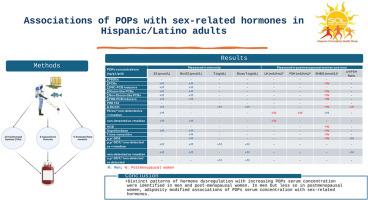Persistent organic pollutants and endogenous sex-related hormones in Hispanic/Latino adults: The Hispanic Community health study/study of Latinos (HCHS/SOL)
IF 7.7
2区 环境科学与生态学
Q1 ENVIRONMENTAL SCIENCES
引用次数: 0
Abstract
Background
Previous studies have demonstrated associations of persistent organic pollutants (POPs) with sex-related hormones; however, findings were inconsistent. Sex-specific impacts and pathways through which adiposity influences associations are not completely understood. We sought to evaluate sex-specific associations of POPs serum concentration with sex-related hormones and to explore pathways through which adiposity may modify associations.
Methods
We studied 1073 men and 716 postmenopausal women participating in the “Persistent Organic Pollutants, Endogenous Hormones, and Diabetes in Latinos” ancillary study which is a subcohort of the “Hispanic Community Health Study/Study of Latinos.” We use baseline examination data collected from 2008 to 2011 to investigate associations between eight organochlorine pesticides (OCPs), five polychlorinated biphenyls (PCB) groups, sum of polybrominated diphenyl ethers and polybrominated biphenyl 153 on sex hormone binding globulin (SHBG) and various sex-related hormone levels. We examined associations cross-sectionally using linear and logistic regression models adjusted for complex survey design and confounders.
Results
PCBs and select OCPs were associated with increased SHBG in women and decreased estradiol (E2) and/or bioavailable E2 in men. For instance, per quartile increase in serum concentrations of ∑PCBs and oxychlordane were associated with decreased levels of E2 (β = −6.36 pmol/L; 95% CI: 10.7,-2.02 and β = −5.08 pmol/L; 95% CI: 8.11,-2.05) and bioavailable E2 (β = −4.48 pmol/L; 95% CI: 7.22,-1.73 and β = −4.23 pmol/L; 95% CI: 6.17,-2.28), respectively, in men, and increased levels of SHBG (β = 7.25 nmol/L; 95% CI:2.02,12.8 and β = 9.42 nmol/L; 95% CI:4.08,15.0), respectively, in women. p,p’-DDT and β-HCCH, and o,p’-DDT were also associated with decreased testosterone (T) and bioavailable T (ng/dL) levels in men. Adiposity modified associations in men, revealing stronger inverse associations of PCBs, PBDEs, and several OCPs with LH, SHBG, E2, bioavailable E2, T, and the ratios of LH to FSH and E2 to T in those with below median body mass index and waist-to-hip ratio.
Conclusion
Distinct patterns of hormone dysregulation with increasing POPs serum concentration were identified in men and post-menopausal women. In men but less so in postmenopausal women, adiposity modified associations of POPs serum concentration with sex-related hormones.

西班牙裔/拉丁裔成人的持久性有机污染物和内源性性相关激素:西班牙裔社区健康研究/拉丁裔研究(HCHS/SOL)
背景:以前的研究已经证明持久性有机污染物(POPs)与性激素有关;然而,研究结果并不一致。性别特异性影响和肥胖影响关联的途径尚不完全清楚。我们试图评估持久性有机污染物血清浓度与性激素的性别特异性关联,并探索肥胖可能改变这种关联的途径。方法:我们研究了1073名男性和716名绝经后女性,他们参加了“拉丁美洲人的持久性有机污染物、内源性激素和糖尿病”辅助研究,该研究是“西班牙裔社区健康研究/拉丁美洲人研究”的一个亚队列。我们利用2008-2011年收集的基线检测数据,研究了8种有机氯农药(OCPs)、5种多氯联苯(PCB)基团、多溴联苯醚和多溴联苯153对性激素结合球蛋白(SHBG)和各种性激素水平的影响。我们使用线性和逻辑回归模型对复杂的调查设计和混杂因素进行了调整,对相关性进行了横断面检验。结果:多氯联苯和选择性ocp与女性SHBG升高和男性雌二醇(E2)和/或生物可利用E2降低有关。例如,血清中∑多氯联苯和氧氯丹浓度每增加四分位数,E2水平就会降低(β=-6.36 pmol/L;95% CI:-10.7,-2.02, β=-5.08 pmol/L;95% CI:-8.11,-2.05)和生物可利用E2 (β=-4.48 pmol/L;95% CI:-7.22,-1.73, β=-4.23 pmol/L;95% CI:-6.17,-2.28),并且SHBG水平升高(β=7.25 nmol/L;95% CI:2.02,12.8, β=9.42 nmol/L;95% CI:4.08,15.0)。p,p'-DDT和β-HCCH以及o,p'-DDT也与男性睾酮(T)和生物利用T (ng/dL)水平降低有关。肥胖改变了男性的相关性,揭示了在体重指数和腰臀比低于中位数的人群中,多氯联苯、多溴二苯醚和几种ocp与LH、SHBG、E2、生物可利用E2、T以及LH / FSH和E2 / T的比值有较强的负相关。结论:在男性和绝经后妇女中发现了明显的激素失调模式,随持久性有机污染物血清浓度的增加。在男性中,肥胖改变了持久性有机污染物(POPs)血清浓度与性激素的关系,但在绝经后妇女中作用较小。
本文章由计算机程序翻译,如有差异,请以英文原文为准。
求助全文
约1分钟内获得全文
求助全文
来源期刊

Environmental Research
环境科学-公共卫生、环境卫生与职业卫生
CiteScore
12.60
自引率
8.40%
发文量
2480
审稿时长
4.7 months
期刊介绍:
The Environmental Research journal presents a broad range of interdisciplinary research, focused on addressing worldwide environmental concerns and featuring innovative findings. Our publication strives to explore relevant anthropogenic issues across various environmental sectors, showcasing practical applications in real-life settings.
 求助内容:
求助内容: 应助结果提醒方式:
应助结果提醒方式:


